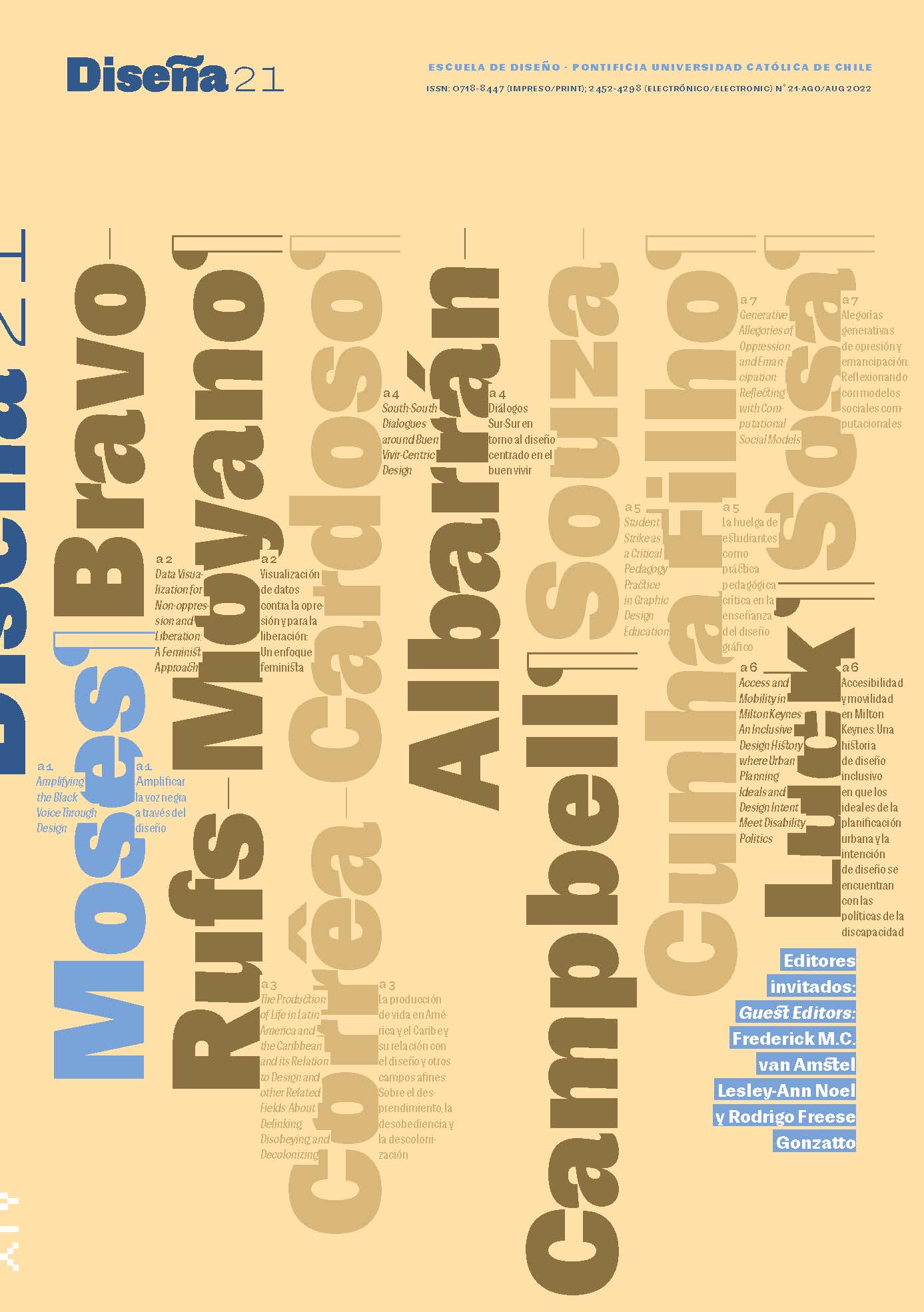Alegorías generativas de opresión y emancipación: Reflexionando con modelos sociales computacionales
Contenido principal del artículo
Resumen
Este artículo presenta un enfoque computacional para el crecimiento de sociedades artificiales (simulaciones basadas en agentes) como una herramienta explícita, accesible y sistemática para visualizar y generar ideas y nuevas preguntas sobre los conceptos de opresión y emancipación de Paulo Freire. Estos modelos no requieren afirmaciones de validez o predicción, sino que su valor radica en su capacidad de estructurar nuestro pensamiento y apoyar nuestra comprensión. Aquí, utilizo simulaciones sociales computacionales como alegorías generativas para reflexionar sobre el papel de los diseñadores en contextos participativos, de codiseño y de diseño social. El artículo muestra cómo las ideas freireanas pueden ayudar a replantear el diseño para transformarlo en un oficio pedagógico basado en el diálogo y la investigación colectiva.
Descargas
Detalles del artículo

Esta obra está bajo una licencia internacional Creative Commons Atribución-CompartirIgual 4.0.

Este obra está bajo una licencia de Creative Commons Reconocimiento-CompartirIgual 4.0 Internacional.
NOTA DE COPYRIGHT
Todos los contenidos de esta edición electrónica se distribuyen bajo licencia Creative Commons de “Atribución-Copartirigual 4.0 Internacional” (CC-BY-SA). Cualquier reproducción total o parcial del material deberá citar su procedencia.
Los derechos de las imágenes publicadas pertenecen a sus autores, quienes otorgan a Diseña la licencia para su uso. La gestión de los permisos y la autorización de publicación de las imágenes (o de cualquier material) que contenga derechos de autor y sus consecuentes derechos de reproducción en esta publicación es de exclusiva responsabilidad de los autores de los artículos.
Citas
Amir, S. (2004). Rethinking Design Policy in the Third World. Design Issues, 20(4), 68–75. https://doi.org/10.1162/0747936042311995
Axelrod, R. (1997). The Dissemination of Culture: A Model with Local Convergence and Global Polarization. The Journal of Conflict Resolution, 41(2), 203–226. https://doi.org/10.1177/0022002797041002001
Bertolotti, F., Locoro, A., & Mari, L. (2020). Sensitivity to Initial Conditions in Agent-Based Models. Multi-Agent Systems and Agreement Technologies: 17th European Conference, EUMAS 2020, and 7th International Conference, AT 2020, 501–508. https://doi.org/10.1007/978-3-030-66412-1_32
Carley, K. M. (2002). Simulating Society: The Tension Between Transparency and Veridicality. Proceedings of Agents 2002, Chicago.
Chomsky, N. (2013). On Anarchism. The New Press.
Costopoulos, A. (2015). How Did Sugarscape Become a Whole Society Model? In G. Wurzer, K. Kowarik, & H. Reschreiter (Eds.), Agent-based Modeling and Simulation in Archaeology (pp. 259–269). Springer. https://doi.org/10.1007/978-3-319-00008-4_11
Dennett, D. C. (2013). Intuition Pumps and Other Tools for Thinking. Norton.
Epstein, J. M. (1999). Agent-based Computational Models and Generative Social Science. Complexity, 4(5), 41–60. https://doi.org/10.1002/(SICI)1099-0526(199905/06)4:5<41::AID-CPLX9>3.0.CO;2-F
Escobar, A. (2018). Designs for the Pluriverse: Radical Interdependence, Autonomy, and the Making of Worlds. Duke University Press.
Freire, P. (2000). Pedagogy of the Oppressed. Continuum.
Gero, J. S., & Sosa, R. (2002). Creative Design Situations: Artificial Creativity in Communities of Design Agents. Proceedings of the 7th International Conference on Computer Aided Architectural Design Research in Asia, 191–198. https://doi.org/10.52842/conf.caadria.2002.191
Gilbert, N. (2002). Varieties of Emergence. In C. Macal & D. Sallach (Eds.), Proceedings of the Agent 2002 Conference on Social Agents: Ecology, Exchange, and Evolution (pp. 41–50).
Gilbert, N. (2005). Simulation for the Social Scientist (2nd Ed.). Open University Press.
Gilbert, N. (2019). Agent-Based Models. Sage.
Kina, V. J., & Gonçalves, A. (2018). The Continuing Relevance of Paulo Freire: Celebrating 50 Years since the Publication of Pedagogy of the Oppressed. Critical and Radical Social Work, 6(3), 363–376. https://doi.org/10.1332/204986018X15388226788293
Macal, C. M. (2020). Agent-Based Modeling and Artificial Life. In M. Sotomayor, D. Pérez-Castrillo, & F. Castiglione (Eds.), Complex Social and Behavioral Systems: Game Theory and Agent-Based Models (pp. 725–745). Springer. https://doi.org/10.1007/978-1-0716-0368-0_7
Martín Juez, F. (2002). Contribuciones para una antropología del diseño. Gedisa.
Resnick, M., & Silverman, B. (2005). Some Reflections on Designing Construction Kits for Kids. Proceedings of the 2005 Conference on Interaction Design and Children, 117–122. https://doi.org/10.1145/1109540.1109556
Reynolds, C. W. (1987). Flocks, Herds and Schools: A Distributed Behavioral Model. Proceedings of the 14th Annual Conference on Computer Graphics and Interactive Techniques, 25–34. https://doi.org/10.1145/37401.37406
Sosa, R. (2022). I am a Creative Loop: Towards Integrative Studios in Design and Creative Technologies. Revista GEMInIS, 13(3), 71–81. https://doi.org/10.53450/2179-1465.RG.2022v13i3p71-81
Sosa, R., & Gero, J. S. (2005). A Computational Study of Creativity in Design: The Role of Society. AI EDAM, 19(4), 229–244. https://doi.org/10.1017/S089006040505016X
Sosa, R., & Gero, J. S. (2008). Social Structures that Promote Change in a Complex World: The Complementary Roles of Strangers and Acquaintances in Innovation. Futures, 40(6), 577–585. https://doi.org/10.1016/j.futures.2007.11.006
Sosa, R., Mejía, G. M., & Adamson, J. (2021). Fluid Worldviews: Designing within the Common Good. In M. Botta & S. Junginger (Eds.), Swiss Design Network Symposium 2021 Conference Proceedings (pp. 1016–1028).
Trigg, A. B., Bertie, A. J., & Himmelweit, S. F. (2008). Modelling Bourdieu: An Extension of the Axelrod Cultural Diffusion Model (Working Paper No. 68; Open Discussion Papers in Economics). The Open University.
Watts, C., & Gilbert, N. (2014). Simulating Innovation: Computer-based Tools for Rethinking Innovation. Edward Elgar.
Yang, L., & Gilbert, N. (2008). Getting Away from Numbers: Using Qualitative Observation for Agent-Based Modeling. Advances in Complex Systems (ACS), 11(2), 175–185. https://doi.org/10.1142/S0219525908001556

